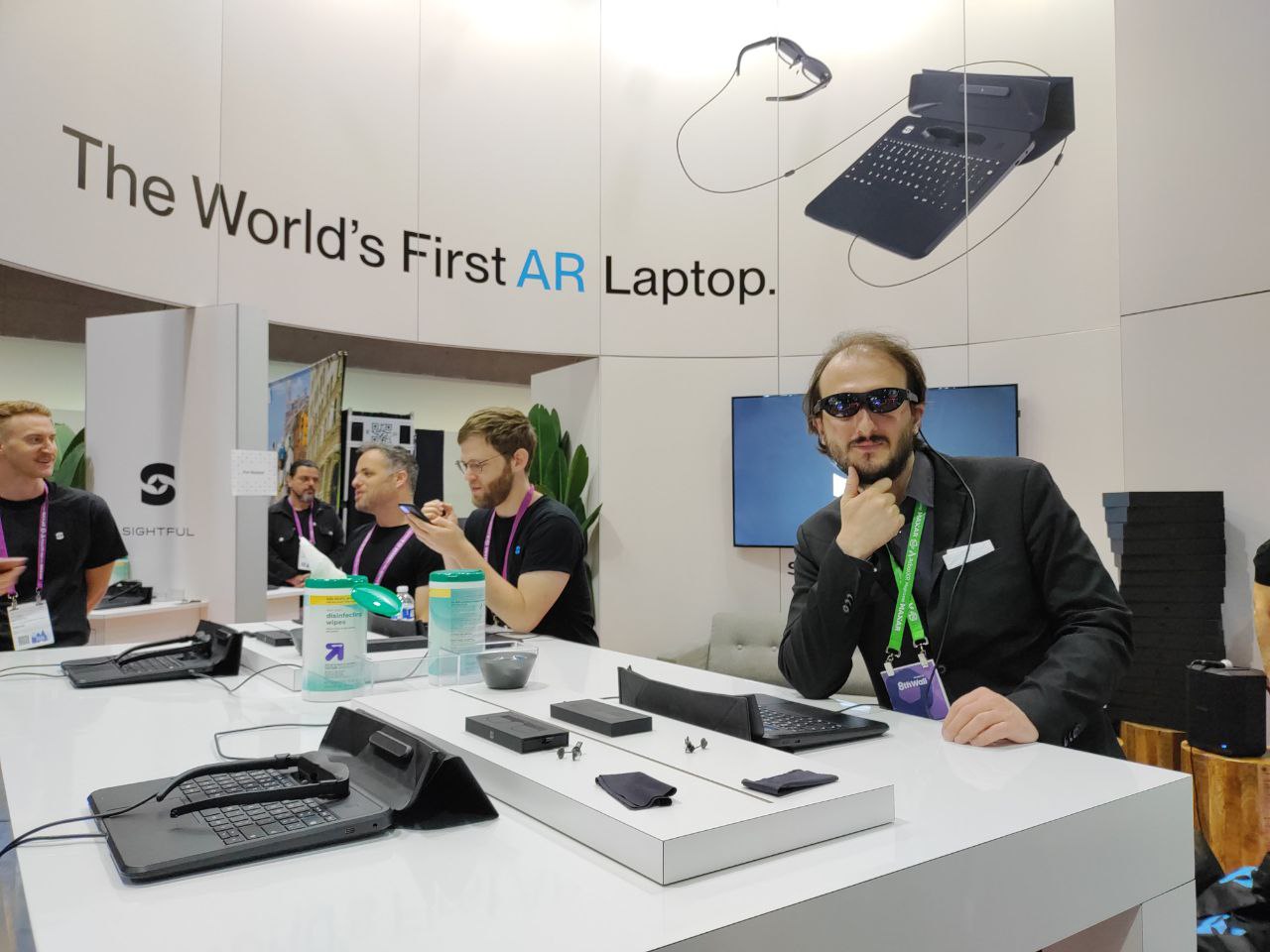AWE 2023 Day 2: Lenovo VRX and Sightful SpaceTop have been the surprises of the show floor
Today it was the first day at AWE in which the show floor opened, and I could start going hands-on with many interesting pieces of XR hardware. I’ve tried many things but I have not the time to describe to you them all today, so let me tell you in this article just what have been the two devices that surprised me the most: the Lenovo VRX headset and the Sightful Spacetop laptop.
(Caveat: I just tried these devices for a few minutes, so do not consider the opinions expressed below as full reviews)
Lenovo VRX
It’s a while since we know that Lenovo is launching a headset of the same category as the Quest 2 but oriented towards the enterprise. The device is called Lenovo VRX and after having tried the device (with a demo from ENGAGE and another one by TechViz), I have to say that is definitely good.
Design
Let me share with you a few pictures of the headset from different points of view. As you can see, the headset is black and elegant and features most buttons and ports that many other headsets in its same category have.







Over-the-top comfort
If there is a feature in which the Lenovo VRX truly shines, that is comfort. I would say that is one of the most comfortable VR headsets I’ve ever tried. Of course, I would need to evaluate it over longer sessions (at least one hour) to judge it properly… but in the few minutes of the demo, I perceived its comfort to be amazing. The headset felt completely balanced on my head and was not front-heavy at all. Its weight was absolutely not too much. The face cushion in leatherette felt good on my skin. It was like having something on my head, but something that “felt light and felt right” and I totally loved that sensation.
After the demo, the Lenovo team showed me that the stop strap can be easily regulated by removing the back nape cover and selecting the right hole on the strap to regulate its length.

Also internally, on the top right and top left corner, there are two little vents with fans behind that can blow a bit of air so that the face of the user stays fresh inside the headset. There are also two little sliding lids to regulate how much air can flow inside.

Everything about this headset has been thought with comfort in mind. Kudos to the Lenovo team for working so well on making the headset comfortable, which is very important for enterprise use cases, where workers have to stay in VR for many hours.
Screen resolution and passthrough
FOV and resolution seemed more or less in line with the ones of Quest 2. There was almost no screen-door effect, but the grid of LCD pixels was visible as a “noise” on top of the visuals you could see in VR.
The headset also features RGB-color passthrough. Passthrough has a good resolution, and I could see the icons of my smartphone through it. This means that it was better than Quest Pro’s one. The depth perception through the passthrough was also good, so I had not the sensation of “flat surroundings” like with Pico 4, but not even the perfect depth reconstruction of Quest Pro. But passthrough suffered especially from persistence issues: while moving my head around, I had the sensation that the image was changing while the old one was still there for a fraction of time, creating a weird blurred effect. Also when rotating my head I could see some warping distortions and perceive a little passthrough lag. On the good side of things, I saw less grainy noise in the passthrough on this headset than in other devices like Quest Pro or Pico 4.
There is no headset with a perfect passthrough and this headset makes no exception.
Controllers


The controllers feature the usual control schema with one thumbstick, two buttons, one trigger, and one grip button. They are lightweight and balanced, and this is good. But the position of the thumbstick and the buttons make the thumb to never feel completely at rest, and also the thumb feels a bit uncomfortable when pressing the two buttons because it has to bend a bit too much, at least for the shape of my hand.
Price and availability
Lenovo VRX is available for $1299 in North America. Before the end of July, it should be available worldwide.
Final impressions

I found the Lenovo VRX a very solid device. Especially I was surprised by its comfort which was just amazing. I would say it is probably the best VR headset that Lenovo ever made, because it offers a good experience on almost all its aspects. If they manage to improve the passthrough quality via software updates, this could become a great enterprise headset for both VR and MR.
Sightful Spacetop laptop
Some days ago, every XR magazine reported the news about the launch of a new laptop that had not a screen, but a pair of Nreal Light glasses attached to it to let you have a huge virtual display in front of you. Seeing the news, I was confident it was something that “sounded good but didn’t work”, but actually trying it I changed completely my opinion about it.
Design

Sightful Spacetop features a slim laptop unit with a keyboard, a touchpad, and some USB ports on it.
On top of the keyboard, there is also an integrated webcam oriented around 45° degrees to be able to frame correctly the user during videocalls. And then hardcoded into the keyboard there is not a display, but a pair of Nreal Light AR glasses. I’ve been told the glasses are hardcoded so there is no way they are removed by accident while you are using the laptop.

Comfort
Nreal Light glasses are very light and comfortable to wear for extended periods of time. But be careful of how you set the nosepad, or you may feel discomfort on top of your nose. Also be careful they don’t become too warm during the usage.
How it works
When I put on the glasses, I could see in front of me a semicylindrical virtual display, which extended for 180° around me (the team told me it could go even beyond that), and that was tall maybe a pair of meters. This virtual display was transparent, but a grid of dots showed me where it was. On the virtual display, I could see the windows that were open on it. It was like in a regular display, but with just some slight “spatial” modifications, like for instance the windows that were on top of others, were really on top of them by a few centimeters, so you could feel the depth difference between the windows on top and the windows on the background. There was also a taskbar through which I could launch a new application, and this taskbar was popping up from the virtual display, too.

I could use the touchpad to move the windows, open them, and resize them, like in whatever PC operating system. There is nothing I should explain to you in this sense, because… it just worked as a standard laptop, with the only difference being that I was using AR glasses to see a big curved virtual display instead of seeing things on a physical monitor. Really, it was natural as using a standard PC, I had to learn nothing new.
The only difference on the interaction side was that I could use three fingers on the touchpad to make the virtual screen become smaller and closer to me or bigger and more distant from me.
The AR glasses and the FOV problem
The glasses provided with the Spacetop tablet are modified XREAL Light glasses. Sightful has worked with XREAL for this project: the glasses are modified in many things (including the firmware) to make sure that the visualization is optimized for laptop usage: for instance, the text readability has been improved. In fact, I can tell you that the visualization of the windows was perfect: crisp colors, readable text, well-defined borders, etc…

The only problem was the FOV of the glasses: XREAL Light has a FOV of around 53 degrees, which is very tiny. It’s not useful having a large screen in front of you if the portion you can see at the same time is even smaller than the one of a laptop screen. Sightful people told me that this way it is even better, because so you can focus on just windows at a time and be focused, but it sounded to me like when we developers want to transform a bug into a feature. I know a few people that use giant screens, and actually, they all want to have full vision of the large screen. So this is not a good thing for this device.

Laptop specs
The laptop is like a Chromebook: it doesn’t run Windows, but a modified version of the Android system created by Sightful. And its chipset is a Qualcomm Snapdragon XR2. All of this is a problem if you would like to use this device instead of your standard laptop: if you want to use Photoshop or Microsoft Word, this is probably not the device you are looking for. But to use the G-doc suite, it is pretty cool.
As for the other specs, I can say it features 8GB of RAM, 256GB of storage, along with enough battery for a claimed 5 hours of work.
Price and availability
Sightful has already opened the order page for the first batch of 1,000 devices priced at $2,000.
Commentary

As I’ve said, I wasn’t expecting much from this device, but actually, it is pretty cool. And it also has some good use cases: for instance, when you are on a plane and you have to work, it’s always hard to open the laptop display lid because the guy in front of you always reclines the seat. With this no-screen laptop, you don’t have this problem and you can work quite well.
The real issue is for me the field of view of the glasses, which limits the productivity: if it was like the one of a VR headset, maybe even just 90°, that could be enough… 53° is really small. So it seems to me a good idea, but probably a bit early on the market. I think it’s a good first edition, which can evolve fairly well over time.
And that’s it with these highlights of my second day at AWE. The third day is starting soon… what other surprise will it reserve for me?
Disclaimer: this blog contains advertisement and affiliate links to sustain itself. If you click on an affiliate link, I'll be very happy because I'll earn a small commission on your purchase. You can find my boring full disclosure here.



